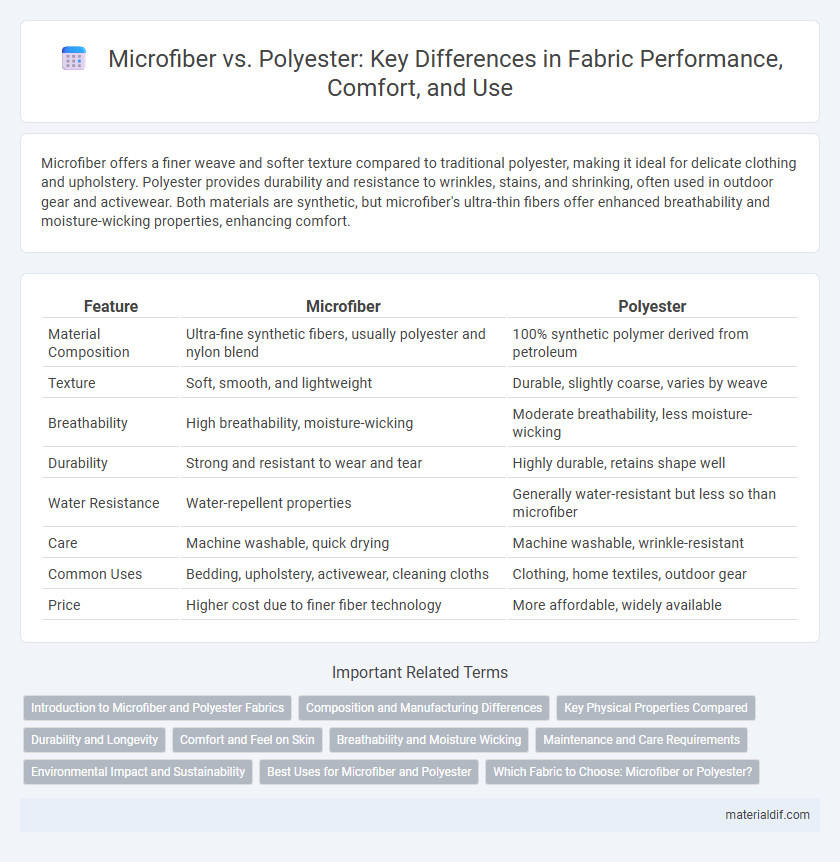Microfiber offers a finer weave and softer texture compared to traditional polyester, making it ideal for delicate clothing and upholstery. Polyester provides durability and resistance to wrinkles, stains, and shrinking, often used in outdoor gear and activewear. Both materials are synthetic, but microfiber's ultra-thin fibers offer enhanced breathability and moisture-wicking properties, enhancing comfort.
Table of Comparison
| Feature | Microfiber | Polyester |
|---|---|---|
| Material Composition | Ultra-fine synthetic fibers, usually polyester and nylon blend | 100% synthetic polymer derived from petroleum |
| Texture | Soft, smooth, and lightweight | Durable, slightly coarse, varies by weave |
| Breathability | High breathability, moisture-wicking | Moderate breathability, less moisture-wicking |
| Durability | Strong and resistant to wear and tear | Highly durable, retains shape well |
| Water Resistance | Water-repellent properties | Generally water-resistant but less so than microfiber |
| Care | Machine washable, quick drying | Machine washable, wrinkle-resistant |
| Common Uses | Bedding, upholstery, activewear, cleaning cloths | Clothing, home textiles, outdoor gear |
| Price | Higher cost due to finer fiber technology | More affordable, widely available |
Introduction to Microfiber and Polyester Fabrics
Microfiber fabric is composed of ultra-fine synthetic fibers, typically made from polyester or polyamide, known for its softness, durability, and moisture-wicking properties. Polyester fabric is a widely used synthetic textile derived from polyethylene terephthalate (PET), valued for its strength, elasticity, and resistance to shrinking and wrinkles. Both microfiber and polyester fabrics offer versatile applications in clothing, upholstery, and cleaning products, with microfiber providing a finer texture and superior absorption compared to standard polyester.
Composition and Manufacturing Differences
Microfiber is composed of ultra-fine synthetic fibers, primarily polyester or polyamide, with diameters less than one denier, enabling a softer texture and greater moisture-wicking properties. Polyester fabric, made from longer, thicker synthetic fibers derived from polyethylene terephthalate (PET), offers durability and resistance to shrinking or stretching. Manufacturing microfiber involves splitting fibers to create a high surface area, enhancing breathability and absorbency, while polyester production focuses on filament spinning for strength and uniformity.
Key Physical Properties Compared
Microfiber features finer fibers, typically less than one denier, resulting in a lightweight, soft, and highly breathable fabric with superior moisture-wicking abilities compared to polyester. Polyester fibers are thicker, offering greater durability, wrinkle resistance, and enhanced tensile strength, making them ideal for heavy-duty applications. While microfiber excels in softness and absorbency, polyester outperforms in resilience and longevity.
Durability and Longevity
Microfiber, composed of ultra-fine synthetic fibers, offers exceptional durability due to its dense weave and resistance to wear, often outperforming traditional polyester in longevity. Polyester fabric, while durable and resistant to stretching and shrinking, can degrade faster under continuous abrasion compared to microfiber. Both materials provide strong fabric options, but microfiber's enhanced fiber technology ensures extended life and sturdiness in high-use applications.
Comfort and Feel on Skin
Microfiber offers a softer, more breathable texture compared to traditional polyester, enhancing comfort and reducing skin irritation. Its finer fibers create a smooth surface that feels gentle and lightweight, ideal for sensitive skin. Polyester, while durable and moisture-wicking, often has a coarser texture that may feel less comfortable during prolonged contact.
Breathability and Moisture Wicking
Microfiber fabric offers superior breathability and moisture-wicking properties compared to traditional polyester, allowing for better air circulation and faster evaporation of sweat. The fine fibers in microfiber create a lightweight, soft texture that enhances comfort during physical activities by keeping the skin dry. Polyester, while durable and moisture-resistant, tends to retain heat and moisture, making microfiber the preferred choice for breathable, moisture-wicking performance.
Maintenance and Care Requirements
Microfiber fabric requires less frequent washing and dries faster than polyester, reducing energy consumption and wear over time. Polyester is more resistant to shrinking and stretching, offering durability with standard machine-washing but may retain odors if not properly cleaned. Both fabrics benefit from low-heat ironing and avoiding bleach to maintain fiber integrity and vibrant color.
Environmental Impact and Sustainability
Microfiber, often made from polyester or nylon, contributes significantly to microplastic pollution due to its fine synthetic fibers shedding during washing, posing a persistent environmental challenge. Polyester, a petroleum-based fabric, has a high carbon footprint and relies on non-renewable resources, but innovations in recycled polyester production help reduce waste and energy consumption. Sustainable fabric choices favor recycled fibers and biodegradable alternatives to mitigate pollution and minimize ecological harm associated with both microfiber and conventional polyester.
Best Uses for Microfiber and Polyester
Microfiber excels in activewear and cleaning cloths due to its lightweight, moisture-wicking, and quick-drying properties, making it ideal for sportswear and household use. Polyester is well-suited for outerwear, upholstery, and durable garments because of its strength, wrinkle resistance, and longevity. Both fabrics offer versatility, but microfiber shines in comfort and breathability, while polyester provides robustness and easy maintenance.
Which Fabric to Choose: Microfiber or Polyester?
Microfiber offers a finer weave than polyester, providing superior softness, moisture-wicking properties, and breathability, making it ideal for activewear and bedding. Polyester is more durable, resistant to stretching and shrinking, and typically more affordable, suitable for outerwear and upholstery. Choosing between microfiber and polyester depends on whether you prioritize comfort and absorbency or durability and cost-effectiveness.
Microfiber vs Polyester Infographic

 materialdif.com
materialdif.com